Finding the best solar power bank can make a real difference when you’re off the grid, traveling, or just want a reliable backup for emergencies. With so many options available, it’s not always easy to determine which ones are worth your money. Some are bulky and slow, while others offer fast charging, wireless features, and rugged designs that hold up in real-world conditions.
What to Expect from Solar Power Banks
Solar power banks sound like the perfect off-grid solution, and in theory, they are. The idea of using the sun to recharge your phone or flashlight on the go feels empowering and eco-friendly. But here’s the honest truth: solar charging is still a backup feature, not a primary one at least for now.
Across all the models we reviewed, the solar panels are best thought of as emergency top-ups. Even the higher-wattage, multi-panel units tend to charge slowly in real-world sunlight, often taking days to fully replenish themselves. That doesn’t mean they’re useless, but it does mean you shouldn’t rely on the solar panel alone for everyday charging.
What these products do offer is a blend of practicality and peace of mind. As power banks, most of them perform really well, with large capacities, multiple ports, wireless charging, and bonus features like built-in flashlights or rugged, waterproof designs.
So why did we still put this guide together? Because the solar component does add value, especially for travelers, campers, and those building a go-bag for emergencies. These are the 10 best solar power banks on the market right now, based on specs, real-world reviews, and thoughtful design. Are they perfect? No. But they’re worth experimenting with if you’re solar-curious and want a power bank that does a little extra.
Our goal here is to help you choose realistically, not ideally, so you can invest in something useful, not just trendy.
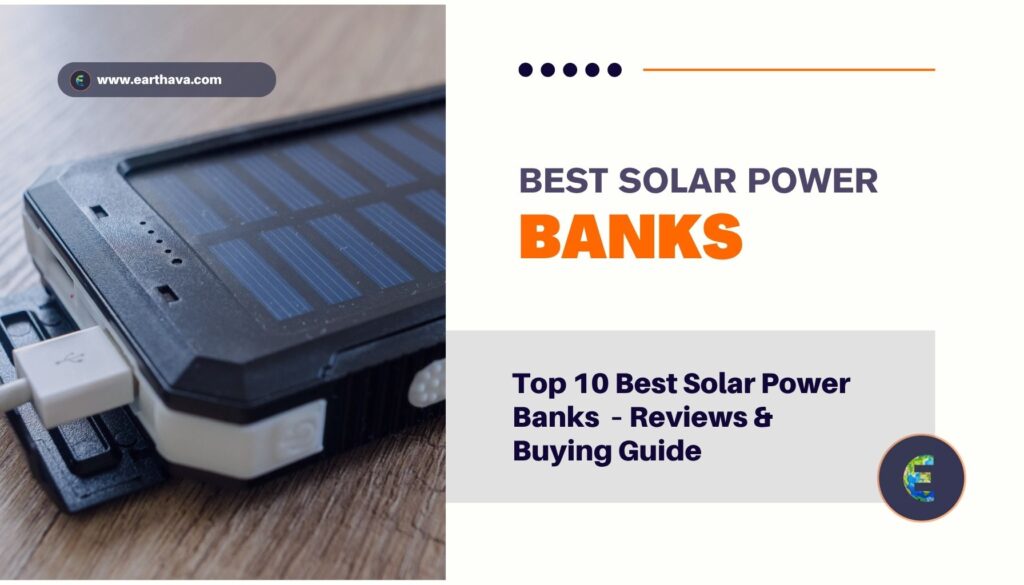
Individual product reviews, key benefits, buying guides, and FAQs.
1. EcoFlow Solar Power Hat
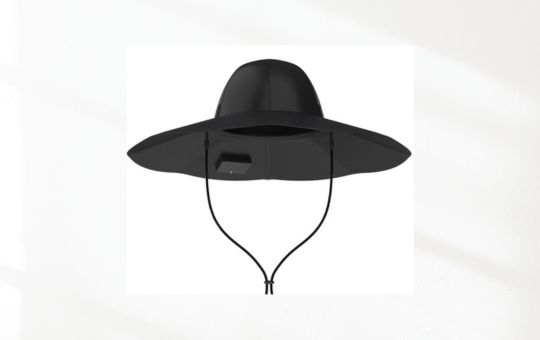
You might be thinking, “Wait a second, this isn’t your average solar power bank,” and honestly, you’re right. It’s not your standard portable charger. But we included it in this list because it brings something refreshingly different to the table, a hands-free, wearable way to generate solar power that, in the right conditions, could actually be more convenient than traditional setups.
Best for: Hikers, campers, or off-grid travelers who want passive solar charging with sun protection
The EcoFlow Solar Power Hat isn’t your typical charging solution. It’s a wide-brimmed sun hat with flexible solar panels built into the brim, designed to charge your devices as you move through the day. It doesn’t store power on its own; instead, it connects directly to your device or a power bank via USB-C. According to EcoFlow and verified reviewers, it can reach up to 8W of output in strong, direct sunlight, which is enough to slowly top up a phone or keep a battery pack going.
What stands out most, based on user feedback, is the freedom it offers. There’s no need to stop and set up a solar panel; you just wear it, or clip it to your gear, and it gets to work. That said, it’s not perfect. Some users described the fit as awkwardly large, particularly in the L–XL version, and noted that the brim feels stiff due to the embedded panel. Performance also drops sharply in shaded areas, which is expected for any solar product, but still worth noting.
From what we’ve gathered, the Solar Power Hat seems best for people already comfortable managing off-grid gear, those who know how to chase the sun, and don’t mind something a little experimental. It’s not going to replace your go-to charger, but it’s a creative solution for trickle-charging while you’re on the move.
What Real Customers Say
Specs And Key Features:
| Price: | $99.00 |
| Battery: | It does not have battery. |
| Input: | – |
| Output: | 5V/2.4A. |
| Solar Panel: | Perc Monocrystalline Silicon. |
| Color: | black. |
| Weight: | 13 Ounces. |
| Dimensions: | Medium-Large:11.02 x 7.48 x 4.72 Inches Large-X-Large: 11.42 x 7.87 x 4.92 Inches |
| Waterproof: | IP65. |
| Key Features: | Wearable. |
2. Riapow: 27000mAh Wireless Solar Charger

Best for: Travelers, commuters, or emergency preppers who want high capacity and multi-device charging, without relying solely on solar
The Riapow 27,000mAh Solar Charger is a high-capacity portable power bank with a built-in solar panel and wireless charging, designed for users who want more flexibility in how they recharge their devices. While it’s not meant to function as a primary solar source (and most users agree on that), its standout strength is the combination of wired and wireless charging with solid capacity, all in a rugged body that’s ready for everyday use or the occasional camping trip.
The Riapow consistently shows up in user reviews as a dependable, all-in-one power bank that’s ideal for those who want to keep their devices running without fuss. The wireless charging is especially appreciated in real-world use, no cables, just set your phone down and let it charge.
That said, the solar panel shouldn’t be your main power source. Like most compact panels, it’s slow and sensitive to light conditions. But for occasional top-ups or in emergencies, it can offer peace of mind, especially when paired with the large internal battery.
It’s a great fit for people who are on the move, whether that’s road-tripping, spending long hours commuting, or building out a backup kit for power outages. It may not be the most ultralight or feature-packed solar charger, but it strikes a balance between versatility, storage, and ease of use that many users find reliable.
✅ Pros
- Charge multiple devices at once: 3 outputs (including USB-C) + 15W wireless pad
- High-capacity battery: 27,000mAh can recharge most phones 5–6 times
- Emergency-ready: Built-in flashlight and solar panel for backup use
- Rugged design: Feels durable and travel-ready, according to buyers
⚠️ Cons
- Solar charging is slow: Based on reviews, the panel is best used for emergencies only
- A bit heavy: Users noted it’s not pocket-friendly and better suited to bags or packs
What Real Customers Say:
Specs And Key Features:
| Price: | $33.99 |
| Battery: | 27000 mAh Li-polymer Battery. |
| Input: | 5V/3.0A. |
| Output: | 5V/3.0A. |
| Solar Panel Wattages: | 1.9W. |
| Color: | Orange. |
| Weight: | 1.76 Ounces. |
| Dimensions: | 6.89 x 3.54 x 1.18 Inches |
| Waterproof: | Yes. |
| Key Features: | 2.5X Faster Charging. |
3. QiSa: 38800mAh Solar Power Bank with Dual 3.1A Outputs

Best for: Campers, travelers, or anyone needing a high-capacity power bank with flexible charging options
The QiSa 38,800 mAh Solar Power Bank is a heavyweight contender in the solar-charger space, featuring a massive battery, three 3A USB outputs, Qi wireless charging, a built-in flashlight, and an integrated solar panel, all packed into a rugged, waterproof body. According to product specs and customer feedback, it’s known for combining traditional and solar-powered charging in a single device
Based on reviews, the high-capacity battery (38,800 mAh) and multiple output options are notable highlights. Most users appreciate being able to charge two devices—wired or wirelessly—without scrambling for cables. One review site noted the combination of large capacity and clean power delivery as a strong selling point.
Our research shows that the solar panel’s effectiveness is limited. While spec lists sometimes mention up to “12 W solar,” many users say this only provides a slow trickle, not a reliable way to recharge the bank on its own.
If you’re looking for a power bank that can handle multiple charges without needing a wall outlet anytime soon, this one fits the bill. With a large battery and a variety of output options, it’s well-suited for longer trips or situations where powering more than one device is part of the routine. That said, based on what users have shared, the built-in solar panel is better thought of as a bonus rather than a main feature; it helps stretch your charge but isn’t fast or powerful enough for full recharges on its own. For anyone building an emergency kit or heading off-grid for a few days, the QiSa offers a solid mix of power, durability, and versatility.
What Real Customers Say
✅ Pros
- Charge multiple devices at once: Dual 3 A USB ports + Qi wireless deliver flexible charging options
- High-capacity battery: Massive 38,800 mAh capacity—plenty of juice for multiple smartphones or tablets
- Emergency-ready: Built-in flashlight and rugged waterproof design (IP66-rated)
- Rugged design – Feels durable and travel-ready, according to buyers
- Overcharge protection: helps keep the battery safe.
⚠️ Cons
- Solar charging is slow: more suited for top-up trickle power
- A bit heavy: Hefty and less portable than smaller power banks.
- Feedback: Mixed on solar effectiveness and value vs claims
Specs And Key Features:
| Price: | $39.99 |
| Battery: | 38800mAh Lithium Polymer Battery. |
| USB Input: | 5V/2A. |
| Solar panel Input: | 5V/3.1A |
| USB Output: | 5V/3.1A. |
| Wireless Output: | 5V/2A. |
| Solar Panel Wattages: | 12W. |
| Color: | Black. |
| Weight: | 1.41 Pounds. |
| Dimensions: | 7.2 x 4.33 x 1.81 Inches |
| Weatherproof: | Yes. |
| Key Features: | Fast Charging. |
4. Survival Frog: Solar Charger Power Bank
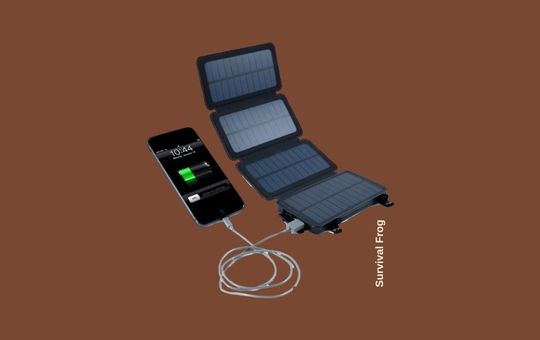
Best for: Day hikers, campers, or emergency preppers who need a compact unit with real solar topping and wireless charging.
The Survival Frog QuadraPro mixes a 8,000 mAh power bank with a four-panel solar setup capable of generating about 5.5 W, Qi wireless charging, dual USB ports, magnetic leather casing, hanging loops, and a built-in flashlight—all while weighing under a pound It’s best known for its clever blend of portability and practical design for outdoor use.
According to reviews, the 4-panel solar layout and stainless steel build are impressive for a device this size. Users especially like the magnets and carabiner loops for mounting the charger to backpacks or vehicles in direct sunlight .
In our research, although the 5.5 W solar rating sounds appealing, actual recharge is more of a slow “top-up” than rapid refuel. One field test reported only about a 5–6% battery gain in 20 minutes of peak light—a decent buffer, but not a full charge solution .
What Real Customers Say
✅ Pros
- Compact and lightweight at just under 16 oz
- Wireless charging + two USB ports—charge up to 3 devices
- Magnetic leather case and hanging loops for easy mounting
- IP-rated and rugged, with a helpful flashlight included
⚠️ Cons
- Solar recharge is slow: best viewed as an emergency top-up only
- Modest 8,000 mAh capacity compared to bigger banks, but it is the actual capacity, as other models may exaggerate
Specs And Key Features
| Price: | $79.97 |
| Battery: | 8000 mAh Battery. “Actual capacity” |
| Solar Panel Wattage: | 5.5W |
| Color: | Black. |
| Weight: | 15.8 Ounces. |
| Water-Resistance: | Yes. |
5. BLAVOR: Portable Solar Power Bank

Best for: Casual users or light travelers who want a compact, straightforward solar charger for small devices.
The BLAVOR Solar Power Bank is a compact, entry-level portable charger that’s best known for blending affordability with just enough features for everyday or backup use. With a 10,000mAh battery capacity, it’s not the most powerful option on the market, but according to user reviews, it delivers dependable performance for light device charging, particularly phones, earbuds, or headlamps.
What makes it stand out is its built-in wireless charging pad, which many buyers found handy when cables aren’t around. It also comes with a small flashlight and compass (It can be inaccurate), thoughtful additions for casual camping or emergency kits. That said, the solar panel is limited in power, and most users agreed it shouldn’t be relied on as a primary charging method. Like most small-panel units, it’s best used in full sun for emergency trickle charging only.
According to our research, this product works well for day-trippers, commuters, or people who want a basic backup battery with bonus features. It’s not a high-performance charger for long outdoor excursions, but for basic needs, it covers the essentials.
Based on reviews and comparisons, the BLAVOR isn’t built for heavy-duty use, but for the price, it offers a thoughtful mix of utility and convenience. It’s a good entry-level choice for those dipping their toes into solar-powered gear.
What Real Customers Say
✅ Pros
- Wireless charging: works well for phones and earbuds
- Emergency-ready: Built-in flashlight is bright and useful at night
- Compact and lightweight: easy to pack or carry
⚠️ Cons
- Solar charging is very slow; best for emergencies only
- Low battery capacity compared to larger models
- Not ideal for charging tablets or multiple devices at once
Specs And Key Features
| Price: | $26.99 |
| Battery: | 10,000mAh Lithium Metal battery. |
| Color: | Orange. |
| Weight: | 10 Ounces. |
| Dimensions: | 5.9 x 3.1 x 0.8 Inches. |
| WaterProof: | IPX4. |
| Key Features: | MultiPurpose. |
6. Hiluckey: 25000mAh Portable Solar Charger
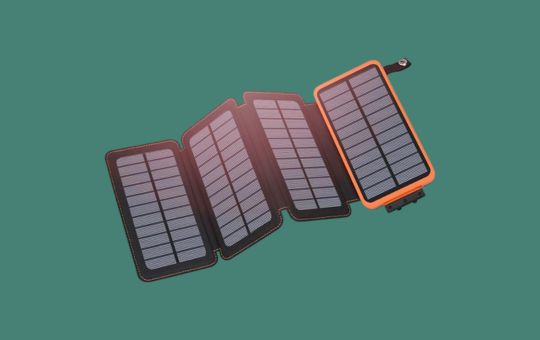
Best for: Campers, backpackers, or road trippers looking for a reliable, mid-range solar power bank with solid capacity and dual charging.
The Hiluckey 25,000mAh Solar Charger stands out for its foldable four-panel design, a feature that, based on reviews, makes a noticeable difference in solar charging efficiency compared to typical single-panel options. It’s a portable power bank built with outdoor use in mind, offering fast USB charging, rugged housing, and enough capacity to charge most phones 5–6 times before needing a refill.
According to users, one of the strongest features is its fold-out solar array. When fully deployed in direct sunlight, it charges faster than many compact solar banks, making it more viable for extended time off-grid. It also includes dual USB outputs and one USB-C port, so you can charge three devices at once, which many found helpful during hikes or group trips.
The main trade-off? It’s bulkier when unfolded, and some buyers noted it’s less convenient for casual, everyday use due to its larger footprint. Still, for people who prioritize function over portability, like campers or those prepping for emergencies, the trade-off is often worth it.
In our research, this charger hits a nice middle ground: not too basic, not overbuilt, and reliably reviewed for what it promises. If you’re heading off-grid for a few days or want an emergency-ready charger with real solar functionality, the Hiluckey earns its spot on the list.
What Real Customers Say
✅ Pros
- Charge multiple devices at once: Dual USB outputs support simultaneous charging
- High-capacity battery: 25,000mAh capacity provides multiple phone charges
- Rugged design: Durable and water-resistant build for outdoor use
⚠️ Cons
- Solar charging is okay; Solar still requires direct sunlight for meaningful results
- Bulkier when unfolded: better suited for travel packs than pockets
- No wireless charging
Specs And Key Features
| Price: | $46.99 |
| Battery: | 25000mAh |
| Max Input: | 5V/2.1A. |
| Max Output: | 5V/2.1A. |
| Solar Panel Wattage: | 6W. |
| Color: | Orange. |
| Weight: | 1.19 Pounds. |
| Dimensions: | 21.3 x 8.7 x 15.4 Inches. |
| Weather-Resistance: | Yes. |
| Key Features: | 4 Foldable Solar Panels. |
7. GOODaaa Portable Solar Power Bank – 36,000mAh with Wireless Charging & LED Light
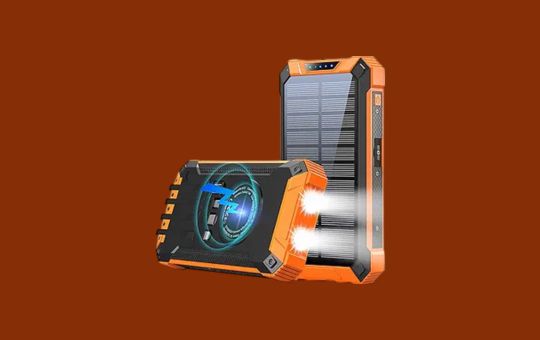
Best for: Travelers and adventurers who prioritize high-capacity backup power and wireless convenience in a rugged design
The GOODAAA 36,000mAh Solar Power Bank is a large-capacity portable charger designed to handle multiple devices at once, ideal for trips, emergencies, or extended time away from outlets. According to reviews and spec comparisons, its biggest appeal is how much charging it can offer before needing to be topped off. The device supports wireless charging, multiple output ports (including USB-C), and even has a built-in flashlight, making it a functional all-in-one unit for people on the go.
In our research, one standout feature is the wireless charging pad, which is especially helpful when all your cables are in use or when you want to charge your phone without adding extra clutter. According to users, it works reliably with most Qi-enabled devices and adds a layer of convenience, especially during travel or outdoor use.
That said, solar charging is its weak spot. Like many power banks with a built-in panel, the solar input is more of a slow emergency trickle than a practical recharging method. Users consistently recommend relying on USB charging for regular use and treating the solar panel as backup only.
Overall, this model suits people who carry multiple devices, phones, tablets, GPS units, or small gadgets. and want the peace of mind that comes with ample backup power. It’s not the lightest option, so it’s better suited to car camping, basecamps, or as part of an emergency kit than lightweight backpacking.
What Real Customers Say
✅ Pros
- Charge multiple devices at once: Multiple ports, including USB-C
- Wireless charging: Qi pad adds cable-free convenience
- High-capacity battery: 36,000mAh powers most phones several times over
- Rugged design: Designed for outdoor use, includes flashlight
⚠️ Cons
- Slow solar charging: Best used for emergencies only
- Bulky: Heavier than compact models; not ideal for ultralight travel
Specs And Key Features
| Price: | $35.99 |
| Battery: | 36000mAh. |
| Max Output: | 5V/3A. |
| Color: | Orange. |
| Material: | ABS & PC. |
| Weight: | 1.4 Pounds. |
| Waterproof: | IPX5. |
| Key Features: | Fast Charging. |
| Climate Status: | Climate Pledge Friendly. |
8. FEELLE: 27000mAh Outdoor Waterproof Solar Phone Charger

Best for: Campers, road-trippers, or outdoor families who want a feature-packed backup with fast charging and moderate rate solar capability
This FEELLE charger combines a sizeable 27,000 mAh battery with a foldable solar panel array, Qi wireless charging, dual-speed USB outputs, and a flashlight, all wrapped in a rugged, splash-resistant design. Based on reviews and spec sheets, it’s best known for offering well-rounded functionality suited to active users who need reliable power with a touch of eco-friendliness.
The real highlight, according to users, is its 22.5 W fast charging capability (via PD and QC standards). Reports suggest it can charge a phone to around 60% in just half an hour, which is noticeably faster than many solar backup chargers. That speed makes it genuinely useful for those on the move.
Our research shows the solar panels only deliver about 6 W in ideal conditions, which means solar charging remains slow and best used for topping off rather than full recharge .d tablets in any situation.
After comparing features and user feedback, the FEELLE model feels like a practical all-rounder. It brings fast, flexible charging and smart extras to the table, and the foldable solar array gives it a survivalist flair, just don’t expect it to fully recharge on sun power alone. For anyone packing light for outdoors or prepping for a power cut, it strikes a solid balance between speed, capacity, and rugged usability.
What Real Customers Say
✅ Pros
- High-capacity battery: Supports multiple phone charges (7–8x)
- Fast charging: 22.5 W output delivers speed and efficiency
- Foldable solar panels: Better solar intake than single-panel units
- Wireless charging + dual USB ports: Flexible power options
- Built-in flashlight and water-resistant design: Useful extras
⚠️ Cons
- Slow solar recharge: Around 6 W makes solar output limited
- Heavier and bulkier than smaller power banks
- Some users report the power button is sensitive in bags
Specs And Key Features
| Price: | $42.99 |
| Battery: | 27000mAh Lithium Polymer Battery. |
| Wattage: | 5W. |
| Color: | Orange. |
| Weight: | 1 Pound. |
| Dimensions: | 6.1 x 3.35 x 1.37 Inches. |
| Weather-Resistance: | Yes. |
| Key Feature: | MultiPurpose. |
9. Jeski: 49800mAh Portable Solar Power Bank
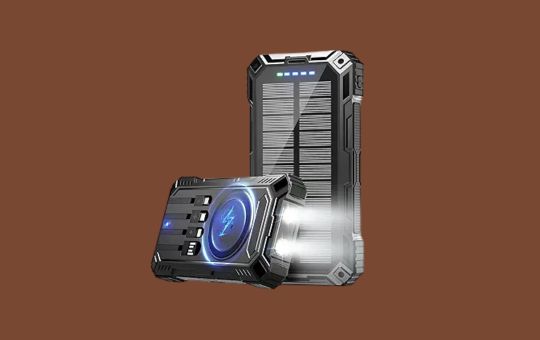
Best for: Campers, road trippers, and emergency-prepared individuals who need massive capacity and flexible charging, while treating solar input as a helpful add-on, not a main feature.
The Jeski 49,800 mAh Solar Power Bank packs a serious punch with its large battery, built-in fast charging (via USB‑C at about 3.1 A), Qi wireless pad, three output options, and even a rugged flashlight، Based on specs and product info, it’s best known for merging giant capacity with versatile charging tools .
According to users, the fast-charging USB‑C port is a real game-changer; it can get you roughly midway to a full phone battery in half an hour, which is a big help when time is tight .
In our research, the solar panel contribution is very modest, a gentle trickle recharge that takes many hours in bright sun to make a noticeable difference .
After comparing specs and feedback, the Jeski power bank delivers serious backup power. It suits situations where you’re away from outlets for days and need to charge phones, tablets, or other gear quickly. Just don’t lean on the solar side too heavily، it helps in a pinch, but isn’t fast enough to go off-grid indefinitely.
What Real Customers Say
✅ Pros
- High-capacity battery: 49,800 mAh capacity—perfect for extended off-grid use
- Fast charging: Fast USB‑C charging means quicker top-ups
- Wireless pad and multiple ports allow charging of several gadgets
- Rugged design (IP65) with a useful flashlight built in
⚠️ Cons
- Slow solar recharge: Solar panel delivers a very slow trickle, best for topping off
- Heavier and bulkier than more compact models
- Expect to plug into wall outlets for full recharge
Specs And Key Features
| Price: | $29.99 |
| USB A Output: | 22.5W. |
| Type-c in/output. | 18W. |
| Micro input: | 5V/2A. |
| Built-in Cable In/Output: | 5V/2A. |
| Solar Panel Wattage: | 2W. |
| Color: | Black. |
| Weight: | 1.21 pounds. |
| Dimensions: | 6.7 x 3.15 x 1.3 Inches. |
| Key Features: | Super Fast-Charging. |
10. LATIMERIA: 45800mAh Solar Power Bank
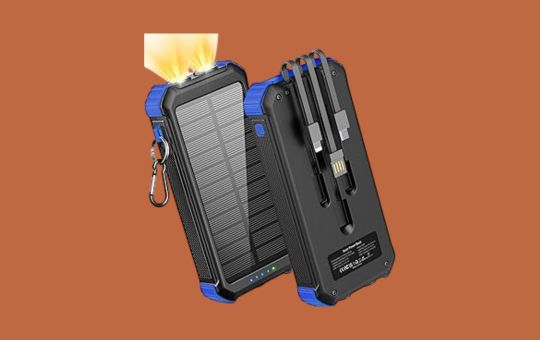
Best for: Road-trippers, campers, and emergency-prepared households needing large backup capacity and multiple charging options
The LATIMERIA 45,800 mAh Solar Power Bank delivers impressive power reserves in a slim, rugged design. Known for its large battery and rich feature set, including fast charging, wireless capability, it’s often recommended for serious off-grid use.
Based on reviews, the fast-charging USB‑C port (rated at 3.1 A) is a crowd favorite; it refreshes a drained phone to about 50 percent in roughly half an hour, a handy boost during busy travel days .
According to users, the solar panel input is slow and better suited for maintaining charge in emergencies, not recharging from empty .
After examining product specs and user feedback, the LATIMERIA power bank stands out for serious charging needs without the fuss. It’s tailored to people who spend extended time off-grid, camping, road-tripping, or stashing a reliable backup in their home or car. Just don’t expect to depend on solar power alone; it’s better as a trickle emergency top-up. If you need a heavy-duty charger that plays well with multiple devices, this one balances capacity, speed, and ruggedness effectively.
What Real Customers Say
✅ Pros
- High-capacity battery: 45,800 mAh capacity—ideal for long trips or multiple-device charging
- Fast charging: Fast USB‑C output refreshes devices rapidly
- Qi wireless pad adds versatility for compatible phones
- Waterproof and rugged design built for outdoor conditions
⚠️ Cons
- Slow solar recharge: Solar recharge is very slow—best seen as a backup top-up
- Heavier and bulkier slightly bulkier than smaller solar chargers
- Requires wall or USB charging for full recharges
Specs And Key Features
| Price: | $49.99 |
| Color: | blue & Black. |
| Weight: | 1.19 Pounds. |
| Dimensions: | 78 x 34.8 x 10.8 Inches |
| Key Features: | Fast Charging. |
Common FAQ
In this section, we’ve gathered answers to some of the most frequently asked questions about solar power banks and their features. Whether you’re new to solar technology or looking for specific details on how these devices work, you’ll find helpful insights to make informed decisions. Browse through the questions below to get clarity on your queries and enhance your understanding of portable solar charging solutions.
How does a solar power bank work?
In Brief, Solar energy is the electrical power that is derived from sunlight. The conversion of this power can either be directly using photovoltaics or indirectly through a concentrated solar panel system. These solar panel systems make use of lenses or mirrors to focus sunlight on a small beam.
When we talk of solar power chargers, the name says it all; it is a battery storage unit of power that derives its energy directly from sunlight. They can be very useful during trips or when there are power shortages. They are becoming popular as each day goes by as more smart devices are being invented and they need more power to work and last for a day. Generally, the power banks act as a backup.
Most people who own a solar charger power bank do not know how they work, and it is very rare to find a seller explaining to a customer how these gadgets work. Solar power banks have special lenses that concentrate the sunlight on a small beam to charge the batteries inside. The battery has a circuit that controls the power flow obtained from the sunlight. These batteries store the electrical energy converted from the sun, which is later used to charge various electrical devices like mobile phones.
What are the advantages of using a solar power bank?
You can use them anywhere! As you know, there are no wires needed with a solar-powered device. You only need to find enough sunlight and place your charger in direct sunlight to charge it up. No matter where you are in the world, you can find some sunshine if you wish to charge your phone or laptop.
They’re environmentally friendly! Another advantage of using solar-powered devices is that they’re environmentally friendly; there’s no pollution from them whatsoever since they don’t release any carbon dioxide into the air like other batteries do when they’re depleted and thrown away after use (because there’s no way for them to be recycled).
They’re durable! Solar-powered devices are also very durable compared with other types of chargers because there are no moving parts inside them (unlike regular batteries). Therefore, there’s no chance of them breaking down quickly.
What are the disadvantages of using solar power banks?
Solar panels take a long time to charge up. If you’re planning on using your solar power bank for emergency purposes, you might be disappointed by how much time it takes for the device to fully charge. Most solar panels can only generate about 2-3 watts per hour — meaning that it could take up to 10 hours for the device to reach full capacity when exposed to direct sunlight.
Another disadvantage of solar power banks is that they are generally quite bulky and heavy compared to regular power banks which don’t rely on solar energy. This means that they’re not always ideal for carrying around in your pocket all day long!
Benefits of using a solar-powered battery charger
Solar battery packs are the most energy-efficient and economical devices that someone can have. They no doubt make life so much easier. There are numerous benefits that they bring to our lives. They include;
1. They can charge without any electrical input. This means that they have no associated costs that they bring along.
2. They can be used anywhere, You just need to have access to sunlight.
3. They are very versatile and can charge any basic gadget. You will never have to worry about any electrical shortages as the sunlight will always be present even for a little while.
How to take care of your solar power bank?
- Keep it dry and clean.
- Don’t leave it in direct sunlight for a long time.
- Unplug the charger when not in use.
- Don’t throw it around or drop it from high places, especially on hard surfaces like concrete or asphalt, as this could cause damage to its internal components or battery cells.
- Don’t immerse your solar charger in water, or let any water get inside the unit (e.g., rainwater). The water could damage the internal circuitry of the solar charger and/or its battery cells. If your solar charger gets wet by accident, immediately disconnect it from any charging device (such as a laptop), then wipe off any moisture with a soft cloth before reconnecting it to charge again.
What are the types of solar energy chargers?
There are many manufacturers, and all of them have different concepts and designs. As a result, there are various models and types in the market. These are the most popular types:
1. Small, portable models that are designed to charge a wide range of small devices, including cell phones, mobile phones, iPods,s or any other small portable gadget.
2. The fold-out models are designed for automobiles. They sit on the dashboard and are plugged into the cigar lighter socket to charge the vehicle battery when it is not in use.
Related: Solar Car Battery Charger kits
3. Public chargers are installed in public places for people to use for free.
Next, we will discuss and feature the 10 best solar power chargers of the first type which are Small portable models.
Why You Can Trust This Review?
We understand that not everyone has the time to dig through pages of reviews, watch product demos, and compare specs across dozens of solar chargers. That’s why we’ve taken the time to do just that. This guide is based on extensive research, pulling insights from verified buyer reviews, detailed spec comparisons, and video demonstrations.
While we haven’t tested this charger first-hand, we aim to give you a clear, honest picture of what to expect from people who actually bought and used it.
Conclusion
Honestly, finding the best solar power bank isn’t about chasing the one with the most features or the flashiest design; it’s about what works when you need it. Whether that’s something tough for hiking or just a reliable charger for day-to-day stuff, it’s worth picking something that won’t give up on you. A lot of these devices promise a lot, but only a few deliver consistently. Hopefully, this list saves you some time and hassle, because digging through dozens of listings can get exhausting fast.
If you’re into greener living or just looking for smart swaps that make a difference, we’ve also got a guide on eco tech products, and if you’re heading off-grid, check out our picks for camping-ready solar chargers. Want to understand how all this solar stuff works? Here’s a simple breakdown: how solar energy powers your gear.
Stay prepared, stay powered, and as always, stay Earthava.



